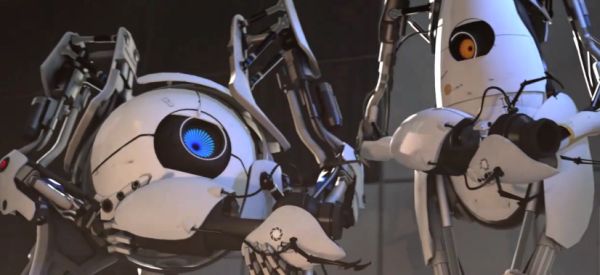
The first time I ever played Portal was damn near magical. Each room I walked into held promise of some diabolical new assault on both my brain and the laws of physics, but I made them look like child’s play. At the time, I was certain it proved I was a genius with an IQ so huge that even my bulging genius brain couldn’t count that high. Of course, I soon came to find out thateveryone experienced Portal that way. So I wasn’t a genius. But the puzzle designers at Valve were.
To this day, Portal stands as the most masterful example of invisibly intuitive teaching I’ve ever discovered. It slowly builds upon itself – sneaking new techniques into your repertoire until you’re snoozing through puzzles that would’ve short-circuited your synapses maybe 20 minutes earlier. Is it a fit for classrooms, though? My first inclination would be to think not. I mean, it’s not exactly a hyper-accurate physics simulation – even with science jokes making up the bulk of both Portal 1 and 2′s brilliantly witty dialogue. That, however, is precisely the point, according to Valve director of education Leslie Redd and designer Yasser Malaika. It’s how Valve games teach – not what they’re teaching – that could help save a rusty, way-behind-the-times education system.
“I think it’s the design approach,” begins Redd, a former senior administrator at The Evergreen School in Shoreline, WA. “It seems like it’s even harder to make something fun than it is to create something that teaches well, or that demonstrates well. So we feel that it’s easier to build the teaching on top of something that’s fun and engaging already.”
“I think what’s really important is for kids to have genuine experiences where they feel that they can accomplish something. And when they’re using the puzzle maker, they’re using a tool which can be used and is used by adults and professionals. They see the opportunities in it. It’s that sense of flow. Portal 2 is challenging. You’re working at the outer level of your capability, but you never get so frustrated that you stop. That is how you have good learning, in pretty much anything that we’re doing.”
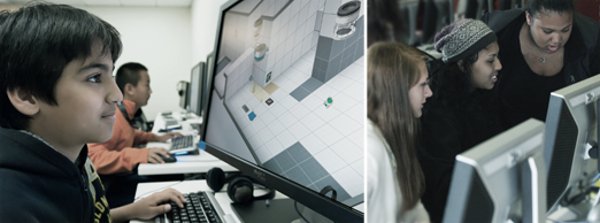
Which is all easy to say, but how does Valve know it’ll actually work? Well, this may come as a surprise to you, but Valve doesn’t simply launch things willy nilly. It pokes, prods, tests, measures, and even trashes stagnant products altogether. On Teach With Portals, that mentality most certainly hasn’t changed. Redd explains:
“As [Portal 2's recently launched] puzzle maker came closer to going through its beta, we also put together a group of about 20 to 25, as we call them, beta test teachers. They were from a diverse group around the country. For instance, we have urban, rural, different socioeconomic levels, private, public, Catholic, online, home school – we just tried to get a really diverse group. Game design teachers, physics teachers, math teachers.”
And that pool, according to Redd and Malaika, is expanding constantly, but not in a haphazard way. Rather, it’s all about adapting to the needs of teachers and students, then rolling findings back into the larger curriculum.
“We responded to things like a teacher writing to us who works in the LA inner-city schools and saying, ‘I don’t know anything about games. I don’t know anything about your company. But is there any way you can help my classes made up of students who cannot pass Algebra 1? They’ve taken it so many times, and if they can’t pass, they don’t graduate. How can you help?’ And for us, that was an impetus to say, ‘OK, can we find a math teacher who can use Algebra 1 concepts within the puzzle maker and Portal 2 to be able to engage students?’”
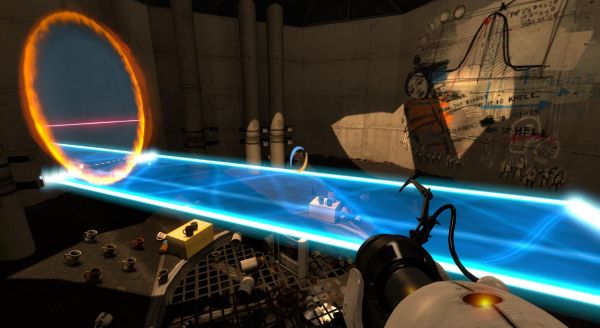
And, on that front, Valve’s had a number of rather pleasant surprises. The idea, explains Malaika, is to provide teachers with less of a framework and more of a mold. Teachers can then shape that mold into whatever’s needed for the task at hand – whether that’s physics, chemistry, math, language arts, or even solving the age-old problem of creativity and outside-the-box thinking being staunchly discouraged in classroom settings.
“Cameron Pittman, a teacher at a science-technology-engineering-math magnet school in Nashville, Tennessee, has been one of the ones who’s pushing in that direction,” notes Redd. “Cameron’s taking the next step, which is teaching kids how to use the puzzle maker and then asking them to design their own experiments. He’ll say something like, ‘Create a chamber that tests the strength of gravity.’
“The kids will come up with completely unique solutions using different game mechanics, and some of them will be better than others, but that springboards to a discussion about engineering processes and the scientific method. It gets kids into the practice of critical thinking and creative exploration and learning from failure as well as success. We see that as a place where games can really shine over rote learning.”
Of course, this is hardly the first attempt in history at using games to teach. Oregon Trail – an American institution that masterfully teaches kids how to commit buffalo genocide and also a bit of US history, I guess – immediately springs to mind. It’s fondly remembered by adults and horse-drawn wagon enthusiasts across the country, and yet, it grinds to a halt after that. But why? Why didn’t such an effective, enjoyable tool kick off a games-in-schools revolution 30-some-odd years ago?
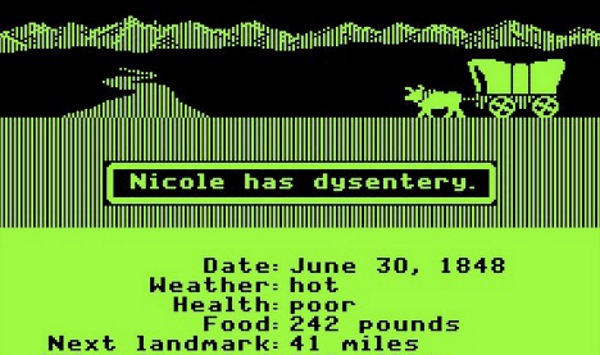
“You know, [the Games For Change conference, where Teach With Portals debuted] has been really interesting,” says Redd, “because, let me tell you, they’re bringing up Oregon Trail. But I think that the mass was not there, the mass interest. And now what is happening in this educational space is, people at the highest levels and at the ground level, the teachers, are all looking at how games can help with learning, and the richness that exists in video games. And also, you have to think about it as being generational. Now, pretty much eveyone’s a gamer.”
“Everyone now has a sophisticated device at their fingertips,” adds Malaika. ”The activity is much more ubiquitous, and game design education is more common. There’s a lot more pieces in place now. And we’ve also solved a lot of the online business transactions. There’s more development tools [readily available to everyone].”
But videogames are hardly the only way game design has infiltrated schools. Gamification, popularized by luminaries like “Reality Is Broken” writer Jane McGonigal, has attempted to overlay game-like elements onto normally mundane activities. Education, especially, has ended up a major focus – though not always for the right reasons. And while Redd and Malaika are happy to see that there’s such a strong desire to dump gallons of oil on education’s rusty old gears, but they also make a sharp distinction between smartly considered principles of game design and sloppily implemented point systems. If, in fact, reality is broken, we need to fix the problem – not slap achievements on it.
“I think that things have to be relevant to people at the end of the day,” explains Malaika. ”You can’t take something that isn’t relevant to somebody, gamify it in some superficial way and expect it to be a good solution. I think that the best gamifications – and I really don’t like that term – are things that express inherently interesting and relevant and valuable information [in an engaging way].”
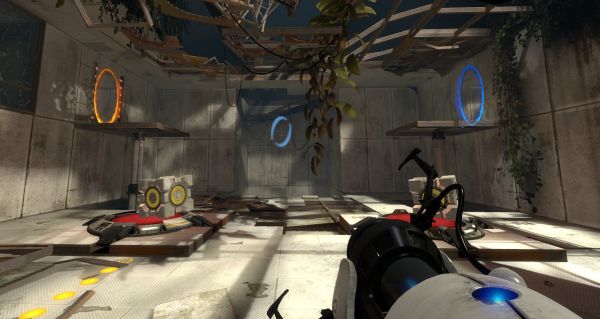
“I don’t think it’s worrisome if people are trying new things, trying to improve the situation,” he quickly adds. “And you never know. Sometimes something will not work, but within failure we’ll learn why, and that gives everybody a sense of where we need to go next. And certainly, coming from a design background, I can attest to the value of failure – repeated failure.”
And ultimately, it’s that mindset that’ll pave the way not just for education to finally catch up with, well, much of the rest of society, but also students using these sorts of programs – Teach With Portals and Steam For Schools included.
“I think that it’s not so much about failing as it is about putting in the effort and learning from the experience,” Redd clarifies. “It’s all about putting in the effort, and through the effort – being uncomfortable and the awkwardness and learning more about the experience in the process – that’s where you have success. Having high-stakes tests and high-stakes experiences and having things track you, those are the parts that make you not want to try. That’s one of the things that’s wonderful in Portal 2. You can just do it again and again and again, you can keep putting in that effort. You can be persistent until you’re able to solve it. That’s a really valuable skill. Persistence is certainly super valuable.”
“Yeah, it’s important for creativity,” adds Malaika. ”If there isn’t a safe way to fail, then it’s really hard to be creative. And what’s more important to teach in schools than how to love learning and how to be creative and engaged?”
So then, for Valve, Teach With Portals is just the beginning of something far, far larger. After all, what’s the point of Steam For Schools if it only has one game? But what’s the next step? Where do we go from here? Well, according to Redd and Malaika, that’s where we enter the picture.

“There are several layers here,” concludes Redd. “We created the platform, the framework, and the tools. Now people have to decide how they want to use it, how far they want to take it. Within that, it’s the enthusiasm and the time and the effort that will carry it further and make it more successful. We’re all going to need to do this together. We need the students, we need the parents, we need the teachers.”
“And we need gamers, to reach out to other developers,” Malaika points out. ”Because we feel that other games have potential to be used in an educational context. I think it’s really important for other developers to steer that, because you know, you’re focused in on your own little world. It’s so much work just to make something fun, in an entertainment context. Knowing that there’s demand and interest was really critical for us. I believe that other developers would feel the same way.”
If you’re interested in seeing more – because I imagine you’ve hit your limit on reading for the day/year/life – you can watch the entirety of Valve’s Games For Change conference presentationhere.
http://www.rockpapershotgun.com/2012/06/23/valve-on-why-games-could-very-well-fix-education/

 @TheVoxelman on twitter
@TheVoxelman on twitter




















